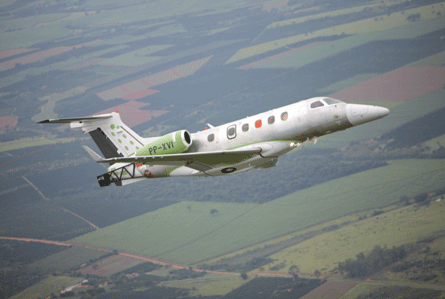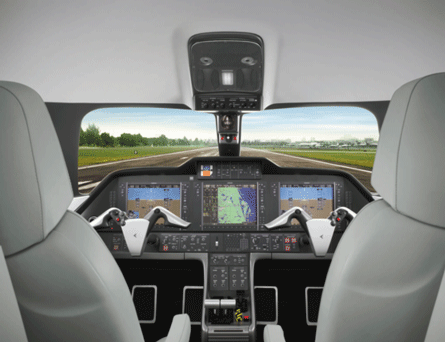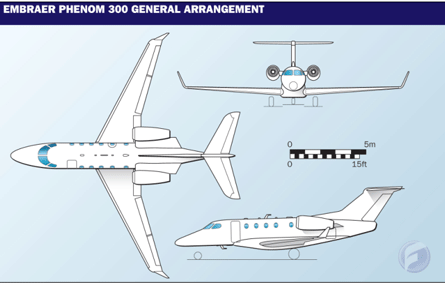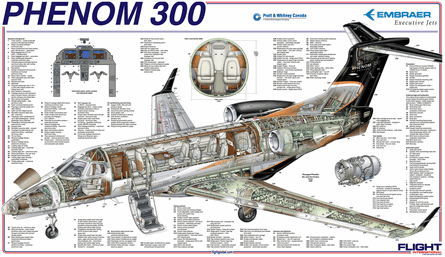When Embraer polled the aviation community about the viability of launching a very light jet in the early 2000s, the Brazilian manufacturer quickly made a discovery that would forever change the vector of its budding executive jet product portfolio.
"We soon realised that a lot of people who buy small jets want to move up to a larger product," says Henrique Langenegger, Embraer's vice-president for executive jet programmes. "We decided we needed a bigger brother for our very light jet offering."
The revelation became the motivation behind the company's seven-passenger Phenom 300 light jet, big brother to the Phenom 100 very light jet and fourth member of the Embraer's executive transport portfolio.
Certification and first deliveries of the $6.65 million twinjet are on track for mid-year in 2009, trailing the expected first deliveries of the $2.98 million Phenom 100 by roughly one year.
As evidence of Embraer's progress in the sector, the company completed the first flight of the Phenom 300 on 29 April, several months ahead of the planned "mid-year" milestone.
The Phenom 300 is but one of a growing family of executive offerings being developed by the Brazilian manufacturer, best known for its nearly 1,500 turboprops and regional jets flying with 105 of the world's airlines.
The light jet follows the same-value formula that Embraer has practised since entering the business jet arena, first with a $25 million ERJ-135 corporate derivate known as the Legacy 600, and second with a VIP version of the $41 million E-190 100-seat regional jetliner, called the Lineage 1000.
 |
|---|
© Embraer |
The formula is simple: price the aircraft to match the competitor's more expensive offering in terms of styling and performance, and offer world-class customer service, honed by years of absolute demand for dispatch reliability from the airline industry.
For the Phenom 300, the "formula" means that the Pratt & Whitney Canada PW535E-powered twinjet has the zip, capacity and spaciousness of Cessna's new CJ4 but is priced at about $1.5 million less.
Phenom 300 owners will be purchasing an aircraft designed and certificated to the most rigorous of Part 23 standards with a product support network optimised by experience with the Phenom 100 VLJ, scheduled for first deliveries in the third quarter this year.
CLEAN-SHEET DESIGN
The "big brother" is by no means a scaled-up version of the VLJ, although Embraer during initial design work in 2004 had considered doing just that, says Langenegger.
By focusing on the end goals - 3,330km (1,800nm) range, Mach 0.78 cruise and a longer cabin - Embraer concluded a "clean sheet" design was needed, with more powerful engines and swept wings with spoilers and winglets.
The Phenom 100 experience weighed in heavily in the design as well, bringing features such as long structural life (28,000 flight cycles or 35,000h), an all-composite T-tail, trailing-link landing gear with fly-by-wire brakes and anti-skid protection.
 |
|---|
The integrated Prodigy cockpit features three Garmin G1000 LCD displays |
Also the same was the Prodigy avionics suite, developed in partnership with Garmin, and a cabin and cockpit interior designed by BMW DesignWorksUSA. The Phenom 300 will be 18% composite structures by weight, not including the interior. That compares with 20% for the Phenom 100.
Designers kept the same "oval-light" cabin cross-section and nose shape, but swept the wings to 27.3° and 24.8° at the leading edge and quarter chord points, respectively.
Although the detachable cast aluminium winglets helped to boost range and "hot and high" take-off environments, the destabilising combination of swept wings and winglets on roll motion during slideslip conditions led engineers to include spoilers as well as ailerons in the roll control laws. Spoilers had been included in the basic design primarily to ensure stopping performance on short runways. Neither the Phenom 300 nor the Phenom 100 has thrust reversers.
To attain design goals for take-off and landing performance, Embraer engineers experimented in the windtunnel with the lift versus drag trade-offs between several wing flap configurations, ultimately deciding on two flap panels with two slots. The Phenom 100 by contrast has single-slotted flaps and no winglets.
Langenegger says London City airport was used as a "reference airport" for steep-slope approaches (the airport has a 5.5° glideslope rather than the usual 3° slope), and Telluride, Colorado, with an elevation of 2,770m (9,080ft), was a reference airport for "hot and high" conditions. Embraer plans to certificate the Phenom 300 for the London City approach roughly one year after service entry.
MOVEABLE TAIL
Due to the aircraft's higher cruise speed, engineers also selected a moveable horizontal stabiliser rather than the Phenom 100's fixed surface. The moveable tail will allow pilots to set different trim positions for take-off and cruise, decreasing the amount of take-off "pull" needed to displace the elevator via the aircraft's traditional cable and pulley controls, also used for the ailerons and rudder. The Phenom 300's spoilers are controlled by hydraulic actuators and flaps are electrically actuated, as are all tabs for trim and autopilot operations.
Structurally, the Phenom 300 is beefier than its sibling, in part due to its higher maximum operating altitude (45,000ft versus 41,000ft for the Phenom 100) and its lower cabin altitude at cruise. Cabin altitude specifications are 6,600ft at 45,000ft and 6,000ft at 41,000ft. The Phenom 100 has a cabin atmosphere of 8,000ft at its maximum altitude of 41,000ft.
From a pilot's perspective, the Phenom 300's integrated Prodigy cockpit will be familiar if not simpler than its sibling's, although separate type ratings will be required for the two models. As before, the panel features three Garmin G1000 12in (305mm) active matrix liquid crystal displays (two flight displays and a multifunction display in the centre) with traditional pilot and co-pilot control yokes. The multifunction display provides access to systems monitoring and flight planning functions including an engine indication and crew alerting system with full-screen synoptic displays and centralised maintenance monitoring functions.
Garmin also provides the aircraft's Mode S transponder with integrated traffic information service, terrain awareness system, XM Satellite weather datalink and audio, digital weather radar with horizontal and vertical scanning capability and dual radio modules with 8.33kHz channel spacing. Pilots access the flight management system and communications and navigation radios through a panel-mounted alphanumeric keypad. Standby attitude, altitude and speed are provided in a single Thales-built display at the top of the instrument panel.
The aircraft's Garmin GFC700 digital three-axis autopilot features dual-channel "fail passive" design with roll, pitch and yaw control as well as automatic pitch trim and Mach trim. A fail passive system maintains the aircraft's trim position, but gives control back to the pilot if a failure occurs. The GFC700 autopilot has a built-in "cruise control" that provides limited throttle authority through the full-authority digital engine controls on the Pratt & Whitney Canada engines to hold a pre-set speed. Again for the Phenom 300, Embraer has brought forward its "dark is good" philosophy for displaying fault information.
Electronic flight bags will be available as optional equipment for the Phenom 300 after service entry, says Langenegger. The Class II devices, in addition to providing a required back-up to Prodigy for a paperless cockpit, will feature a performance calculator to help pilots determine precise take-off distances from any airport.
At the request of operators, Embraer has simplified the icing protection of the new jet by having both "hot wings" and a "hot tail", a combination made possible by the larger engines and a great deal of engineering.
"When we held our customer advisory board and talked to fractional operators, they complained about [mixed mode anti-ice systems]," says Langenegger. "We didn't want the pilot to worry about two types of systems, so we'll have one type of system behaviour."
ICE ACCRETION
Whereas the Phenom 100 uses heated air from the engines to heat the leading edge of the wing and pneumatic de-icing boots on the horizontal stabiliser, the Phenom 300 will use bleed air for both horizontal wings. Like the smaller VLJ, the Phenom 300 allows ice to accrete on the vertical stabiliser, a condition that will be proven safe in certification testing.
Key to providing a hot tail was developing a "smart" bleed air system. "The bleed is much better than for smaller engines, but there's not plenty," says Langenegger. The solution, a variable bleed system that varies with altitude and speed and engine condition, was crafted by engineers at Embraer and GE (formerly Smiths Aerospace), provider of the anti-ice control system, with help from Pratt & Whitney Canada.
Other enhancements include the installation of a Goodrich "Smart Probe" to electronically measure the wing's angle-of-attack, slide-slip angle and airspeed. The device, also used on E-Jets, is more accurate than traditional pitot-static systems at low airspeeds, and it eliminates a number of line replaceable units as well as traditional pitot tubes, static ports and the interconnecting plumbing.
Standard for the cabin is a small forward galley and seven seats that move forward and sideways. Rotating seats are optional, as is a two-person side-facing divan that can be installed in lieu of the seventh seat in the front.

In-flight entertainment packages come in three varieties: the basic package offers an audio system with CD player and speakers the best value option has an audio and video player and 10.4in display that comes down from the ceiling, with wireless headphones and remote controls the premium system adds video displays in front of every seat.
At the rear is a lavatory with a sink, running water and external servicing. Behind the lavatory and the rear pressure bulkhead is a 1.9m3 (66ft3) unpressurised cargo hold, large enough to hold six pairs of skis (or six golf bags), six roll-on bags and six laptop computer bags. Overall there is 2.2m3 of baggage space.
Aftermarket support for the new jet will be identical to Embraer's offering for the Phenom 100. The company will be the single source for spares for the airframe and engines, with the caveat that customers will also be able to obtain engine support directly from Pratt & Whitney Canada if desired.
Spares stock will primarily be held in delivery company UPS's logistics hub in Louisville, Kentucky. Edson Mallaco, senior vice-president, aviation services, says Embraer will guarantee delivery of those parts by 10:00 the next day for orders placed up until midnight the night before.
Embraer is building inventories of parts in Louisville and testing software that integrates the back end of the two companies' databases so that Phenom 100 and Phenom 300 customers will be able to track part delivery status from Embraer's website.
Parts will be available at Embraer's four service centres, three in the USA and one at Le Bourget in Paris. The Le Bourget centre was certificated in March, and Mallaco says the three US sites - Ft Lauderdale, Florida Mesa, Arizona and Windsor Locks, Connecticut - will be open by the third quarter this year.
Mallaco expects most customers of the Phenom 300 to select Embraer's Executive Care (EEC) support programme, which covers the aircraft beyond the initial three-year warranty. Standard and enhanced total care per-hour contracts, now being marketed to Phenom 100 customers, will take coverage out to five years or longer on a cost per-hour basis.
Training for Phenom 300 pilots and mechanics will be provided through a joint venture between Embraer and CAE and will take place at CAE's Simuflite centre in Dallas, Texas. A second training centre is planned at Burgess Hill in the UK in 2009.
Embraer continues to expand, most recently filling the gap between the Phenom 300 and the Legacy 600 with two new models. "The two brothers will now be joined by two bigger brothers," says Langenegger of the newly announced Mid-Light and Midsize jets, a pair that will be given names at the EBACE trade show in Geneva next week. There is talk of a third new model as well. "The portfolio allows us to move up in small steps," says Langenegger.
 |
|---|
© Giuseppe Picarella/Flight International |
Source: Flight International



















